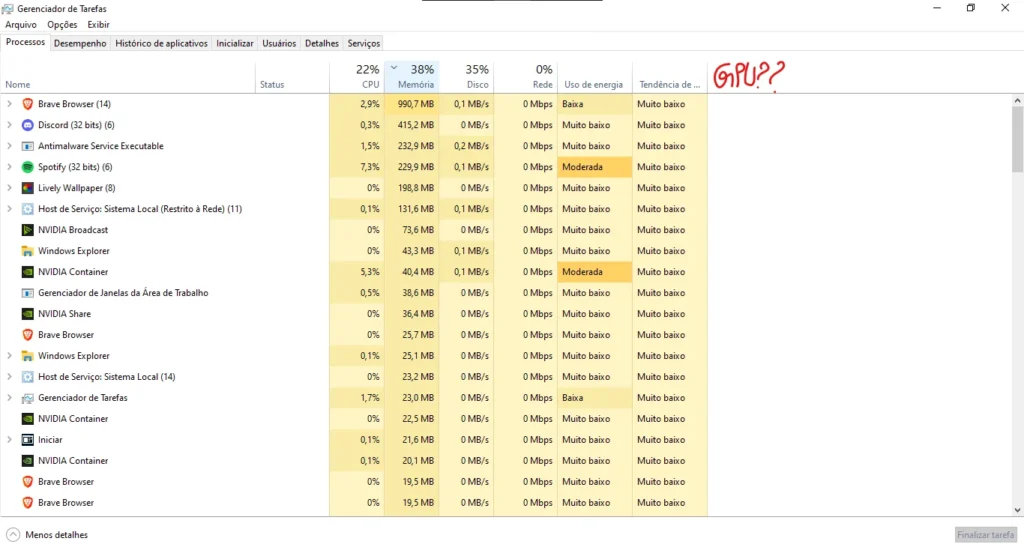Are you experiencing the frustrating issue of your GPU not showing up in the Task Manager on your Windows 10 or Windows 11 system?
This problem can hinder your ability to monitor and manage your GPU’s performance effectively. However, there’s no need to worry, as there are several potential solutions to this issue.
In this blog, we will explore various methods to troubleshoot and resolve the GPU not showing up in Task Manager problem, ensuring that you can efficiently monitor your GPU’s performance.
How To Fix GPU Not Showing Up In Task Manager (Windows 10 & Windows 11)?

To fix GPU not showing up in Task Manager (Windows 10 & Windows 11), you can unhide the GPU column in task manager, update graphics drivers, and repair corrupted system files. Additionally, you can update BIOS, and rebuild the performance counter.
1. Unhide The GPU Column In Task Manager
Sometimes the GPU column might be hidden in the Task Manager. If it’s not visible, you won’t be able to monitor your GPU’s performance.
By unhiding the GPU column, you can easily keep track of your GPU usage in real-time.
- Right-click on the top bar of the Task Manager’s “Processes” tab.
- Click on the “GPU” option to make it visible. If it was previously unchecked, this would add the GPU column to your Task Manager view.
2. Update Graphics Driver
Outdated or corrupt graphics drivers can prevent the GPU from showing up in Task Manager.
Keeping your drivers up-to-date ensures compatibility with the operating system and can resolve issues related to hardware visibility and performance.
- Right-click on the Start menu and select “Device Manager.“
- Expand the “Display adapters” section, right-click on your graphics card, and choose “Update driver.“
- Select “Search automatically for updated driver software” and follow the prompts to install any available updates.
3. Repair Corrupted System Files
Corrupted system files can cause various issues, including the GPU not showing up in Task Manager. Running system file checks can repair these files and potentially resolve the issue.
- Open Command Prompt as an administrator.
- Type sfc /scannow and press Enter.
- Wait for the scan to complete and follow any instructions to repair corrupted files.
4. Update BIOS
Sometimes, the issue may stem from an outdated BIOS, which can lead to hardware incompatibilities.
Updating the BIOS can help ensure that all components, including the GPU, are recognized by the system.
- Check your motherboard manufacturer’s website for an updated BIOS version.
- Download the BIOS update and extract it if necessary.
- Follow the manufacturer’s instructions to update the BIOS, which may include creating a bootable USB drive or using a BIOS update tool.
5. Rebuild The Performance Counter
The performance counter is used by Task Manager to display system metrics. If it’s corrupted, it might not show the GPU usage.
- Open Command Prompt as an administrator.
- Type lodctr /r and press Enter to rebuild the performance counter.
- Restart your computer and check if the GPU now appears in Task Manager.
6. Check For Windows Updates
Ensuring that you have the latest Windows updates can resolve compatibility issues and introduce new system features that may help recognize your GPU in Task Manager. Windows updates can include driver updates that could fix the issue of the GPU not being detected.
- Click on the Start button, then go to Settings > Update & Security > Windows Update.
- Click on “Check for updates” to prompt your system to search for the latest updates.
- If updates are available, install them by following the on-screen instructions.
- After the updates are installed, restart your computer and check if the GPU now shows up in Task Manager.
7. Disable Power Saving Mode
Power-saving features in Windows can sometimes limit the performance of hardware components, including the GPU, to conserve energy. This can occasionally lead to the GPU not showing up in Task Manager.
Disabling power saving mode can help ensure that all hardware components are running at full capacity.
- Right-click on the battery icon in the system tray and select “Power Options” or “Battery settings.”
- Click on “Change plan settings” next to your selected power plan.
- Then click on “Change advanced power settings.“
- Expand the “PCI Express” and then the “Link State Power Management” settings.
- Set the setting to “Off” to ensure that power saving for PCI Express does not affect your GPU performance.
- Click “Apply” and then “OK” to save the changes.
- Restart your computer and check if the GPU appears in Task Manager.
8. Contact Microsoft Support

If you’re experiencing persistent issues with your GPU not showing up in Task Manager and suspect it might be related to Windows, reaching out to Microsoft Support can provide you with specialized assistance.
Microsoft’s support team can offer guidance on operating system-related problems and help troubleshoot more complex issues.
